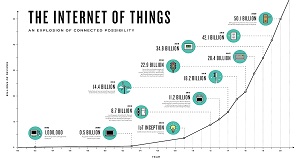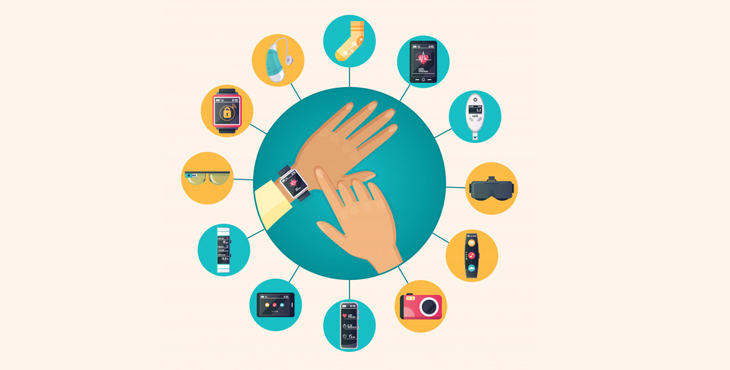In recent years, wearable technology has become more widely available. The primary reason for this is because the semiconductor components and development tools necessary to design and manufacture smaller, more complex circuits are now available on the open market at affordable prices. These new components and advanced tools now allow smaller teams of developers to design and build devices that were previously in the exclusive domain of much larger development teams working with in-house proprietary components and tools. Furthermore, sensor technology (e.g. blood-pressure, oxygen levels, and blood-sugar sensors) has advanced dramatically and continues to advance further into the world of nanotechnology - creating yet smaller and lower power sensors. When we consider these technological advances, and further consider the wireless infrastructure that is growing around us daily, the increased interest in wearable devices is easy to understand.
The economic viability of wearable technology in today's marketplace is inextricably linked to the wireless infrastructure that surrounds us in our daily lives - and a large portion of that wireless infrastructure is designed and built (if not owned and operated ) by a handful of companies with resources well beyond that of a small design team. The infrastructure these large companies provide, either through sale or lease, range from smartphones to cell towers to satellite communications equipment. This article will focus on how a small design team leverages this existing wireless infrastructure into something much larger than their own efforts...and not only can it be done, but the companies who own and operate the wireless infrastructure are dedicated to making this happen. Well, some of them anyway...
the wireless infrastructure
First of all, it should be noted that some of the most ambiguous terminology on the planet comes from the telecommunications world. For example, 'the cloud' is a somewhat, if not intentionally, ambiguous description of the mass of electronic processing, communication, and data storage equipment that powers the internet; this is an entity whose mass and form are indeed constantly changing - thus the name fits. Also important to note is that the cloud would not be what it is today without the wireless infrastructure that has grown with it; what started out as stationary equipment communicating over copper wires now includes low power mobile devices, communications towers, earth-stations, and satellites - all communicating wirelessly.
Industry has categorized these wireless networks as follows:
- cellular networks: GSM, CDMA, LTE
- low-power wide-area networks: LoRa, RPMA, SigFox
- low-rate wireless personal area networks: zigbee, 6LowPAN, WirelessHart
- wireless personal area networks - bluetooth, WiFi
For the purposes of this discussion, only two of these categories will be considered (cellular networks and wireless personal area networks) as these are by far the most ubiquitous wireless technologies available to consumers. The remaining categories will be the subject of future discussion. Furthermore, WiFi will be excluded from this discussion as bluetooth is the preferred wearable technology due to its lower power consumption.
you already own an internet gateway
Smartphones employ not only cellular communications but they also support bluetooth communications. Therefore, the smartphone can effectively be used as a 'gateway' between bluetooth-enabled wearables and the cloud - where data can be accessed through a number of ways; the most user-friendly way, of course, being with a web browser (e.g. Chrome, Firefox, or Internet Explorer) on any internet-connected computer, tablet, or smartphone.
The best thing about using the smartphone as your solution's internet gateway is that your customers already own the hardware (their smartphone) and, after they install your free smartphone app, the wearable will be their sole purchase. It should, however, be noted that there are a few issues with using your smartphone as your gateway. First, the range for blueooth is in the the 'tens-of-meters' range at best. Therefore, as with a bluetooth audio ear-piece, your wearable device cannot get too far from your smartphone before the wireless connection is lost. Second, power-hungry smartphones need to be recharged daily and this requires a human in the loop - which does not bode well for system reliability. The drawbacks to using a smartphone as the internet gateway will be discussed further- but lets first discuss the smartphone's bluetooth features.
bluetooth
The bluetooth protocol provides wireless connectivity on a wireless personal-area network (WPAN). The most common is bluetooth connectivity is point-to-point, that is, between your smartphone and a, generally smaller, battery powered device such as a bluetooth audio headset. This bluetooth connection transmits at a higher data rate than is required of devices that don't require audio - which includes the vast majority of wearables. This is why a subset of the bluetooth standard was created to transmit at much lower data rates and, thus, consume less battery power; this is called bluetooth low-energy (BLE).
In the world of wireless wearable technology, BLE is king; mostly because everyone has a smartphone that can seamlessly download an app and subsequently communicate with a bluetooth device after a very straightforward setup procedure that may easily take less than one minute. The data from the wearable can then be viewed immediately on the smartphone or uploaded to the cloud for long-term storage and viewing at a later date.
While this WPAN solution may solve most of the requirements to get your wearable device to market, there is still one issue worth talking about and that is system reliability. It soon becomes obvious that if the user doesn't charge their smartphone, or forgets to take there smartphone with them when they travel, or simply walk too far away from their smartphone, there will be 'down-time' when the connection drops. Depending on your application, this may or may not be an issue and each application needs to be evaluated on its own merits as regards system reliability. If system reliability is an issue then we need to consider getting the cell phone out of the reliability equation. The obvious choice would to design direct cellular connectivity into your wearable. Sadly, this turns out to be a short conversation as regards wearables; the next section addresses some of the issues involved with direct cellular connectivity - and later we will detail some options.
direct cellular connectivity
As regards a direct connection with wearable devices, cellular functionality is indeed possible - and a few wristwatches (e.g. Apple's AppleWatch Series 3, Samsung's Gear S3 and Timex Ironman One GPS+) have captured the market's attention. All of these watches are somewhat large compared to what most people would call an attractive, or even comfortable, wristwatch and the expense required to design and manufacture even these large form-factor cellular wristwatches remains in the hands of the relatively few companies that have the resources to pursue this market. Additionally, these wristwatches have small batteries and they become yet another device that needs to be charged every night along with your smartphone. This, however, is not to say wearables cannot leverage the cellular infrastructure; indeed they can and we will talk more about this in a later discussion.
In general, direct cellular connectivity is achievable but at the cost of physical size, as previously mentioned. One option would be to compensate for the increased size by attaching your wearable with an arm-band, or carrying it in a fanny pack, or wearing the device as a pendant - all these non-electrical options would compensate for the larger size necessary to add the required electronics for direct cellular connectivity to your product. They may also allow for a larger battery which would increase time between charging and, thus, increase system reliability which, as mentioned earlier, is an issue with using your smartphone as an integral part of your system solution.
in summary
Primarily, only two wireless technologies have been discussed here: cellular and bluetooth. More discussion would surely include WiFi, Zigbee, and several low-power wide-area networks (LoRa, RPMA, SigFox, etc) that are rapidly being deployed world-wide. Stay tuned for more discussion...and in the meantime check out our info page for a detailed listing of WTSi's wireless capabilities: wireless technologies



